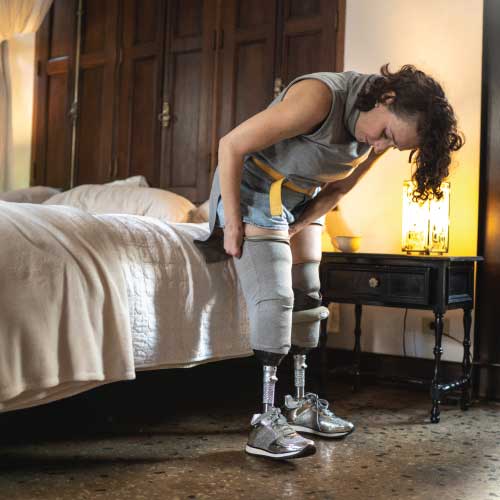Prosthetic Legs Don’t Give Athletes Unfair Advantage—study
Specialized prosthetic legs for running have enabled athletes with bilateral leg amputations to surpass the qualifying standards for the Olympic 400-meter race. Because these adaptive athletes clock in relatively fast finishes, many assume prosthetic legs provide an unfair advantage over biologically legged competitors. These assumptions have led athletics governing bodies to prohibit prosthetic legs in authorized non-amputee competitions, like the Olympics.

However, do adaptive runners have an unfair advantage when using running blades? Researchers sought to find out.
The researchers tapped the fastest 400-meter athlete with a bilateral below-knee amputation. The 29-year-old adaptive athlete (we will refer to him as the "fastest BA") performed a series of tests over five days after his competition season when he ran a season-best 400-meter race in 44.42 seconds. For each test, he used his passive-elastic carbon-fiber competition prosthetic leg—an Ottobock 1E90 Sprinter.
The researchers tested the athlete's acceleration, maximum running velocity, aerobic capacity, endurance, and more. Then they compared his data to other amputee athletes (with bilateral and unilateral amputations) and non-amputee athletes.
Initial Acceleration
Accelerating to top speed helps athletes get ahead early in the race, making it an important metric. According to the test, the fastest BA's average to sprint 20 meters from a starting-block position was 40% slower than that of elite non-amputee athletes.
Maximum running velocity
The athlete with the fastest maximum velocity can outperform their competitors and cover more distance for a given duration. The researchers found that the fastest BA was quicker than any other bilateral athlete (11.4 meters per second).
The researchers found his record of being similar to but not faster than the fastest non-amputee athlete (11.72 meters per second) or adaptive athlete with unilateral leg amputation (11.55 meters per second).
The fastest bilateral amputee was found to be similar to, but not faster than the fastest non-amputee athlete.
The researchers also compared the ground reaction force between the fastest BA and non-amputee athletes on a treadmill at 10 meters per second. The ground reaction force refers to the pressure exerted by the ground on a body in contact with it. This metric is important because it influences the athletes' running velocity.
Overall, the researchers found that the fastest BA's average vertical ground reaction force was similar to those of non-amputee athletes. When they compared the fastest BA with the second-fastest bilateral amputee—who used stiffer running prosthetic legs—the latter produced 19 to 23% lower stance average vertical ground reaction force relative to body weight. The adaptive athlete also took 14% shorter and more frequent steps. This data affirms athlete physiology and prosthetic configuration's effect on running biomechanics.
Athlete physiology and prosthetic configuration affect running biomechanics.
Aerobic capacity, endurance
During a 400 m race, athletes expend metabolic energy via aerobic and anaerobic metabolism. If other performance metrics are equal, the athlete with a faster velocity at aerobic capacity outperforms others in a 400 m race.
The researchers found that the fastest BA's vV̇o2 peak (intense running pace) was 14% lower than the second fastest BA. Meanwhile, the latter's vV̇o2 peak was nearly identical to the average vV̇o2 of non-amputee 400-meter athletes but 19% slower than non-amputee distance runners.
The researchers also found that the fastest BA's average aerobic capacity and running economy were better than other adaptive athletes. He was also 19% better than non-amputee 400-meter athletes and similar to non-amputee distance runners.
Although athletes with prosthetic legs turn out to be relatively economical runners, the lower V̇o2 peak of adaptive athletes contributes to a vV̇o2 peak that is not faster than that of non-amputee 400-meter athletes and distance runners.
As for endurance—crucial for helping athletes deal with fatigue—the researchers found that the 400-meter athletes with prosthetic legs don't appear to have better sprint endurance profiles than non-amputee athletes.
Athletes with prosthetic legs don't appear to have better sprint endurance than non-amputee athletes.
Study limitations
As with any other study, the researchers acknowledged that this study has limitations, but these can inform future studies. The researchers noted that it's uncertain how fast an adaptive athlete could run 400 meters if they were non-amputee athletes wearing athletic footwear. There's currently no base metric for that.
Furthermore, there is currently no published model that accurately predicts a 400-meter performance.
But limitations aside, the researchers concluded that no bilateral amputee athlete using running prosthetic legs, including the fastest one, shows a single 400-meter running performance metric better than those achieved by non-amputee athletes.
In addition, the researchers found that the best-measured velocity at aerobic capacity, initial acceleration, and maximum velocity were 19%, 40%, and 1-3% slower than non-amputee athletes, respectively.
Therefore, the study found that using prosthetic running legs during 400-meter running races is not advantageous compared to using biological legs.











































































